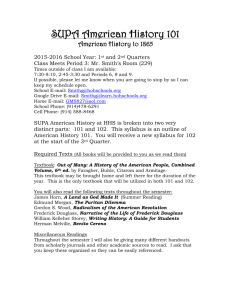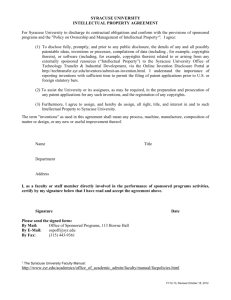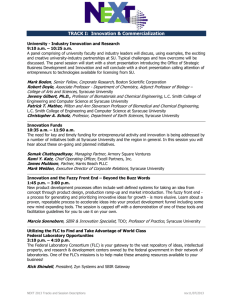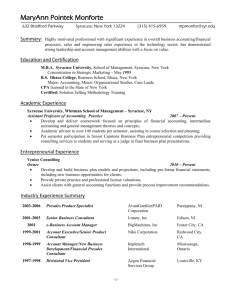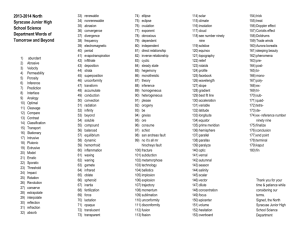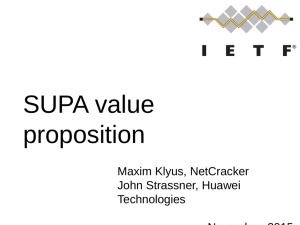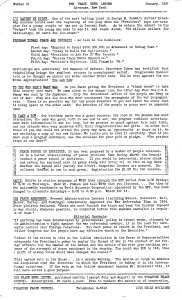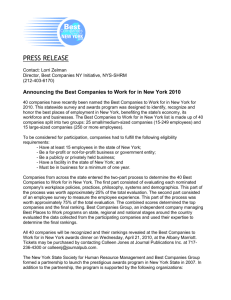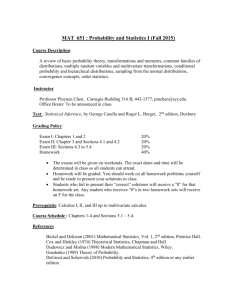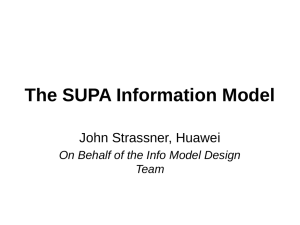(SUPA) Public Affairs - Government
advertisement
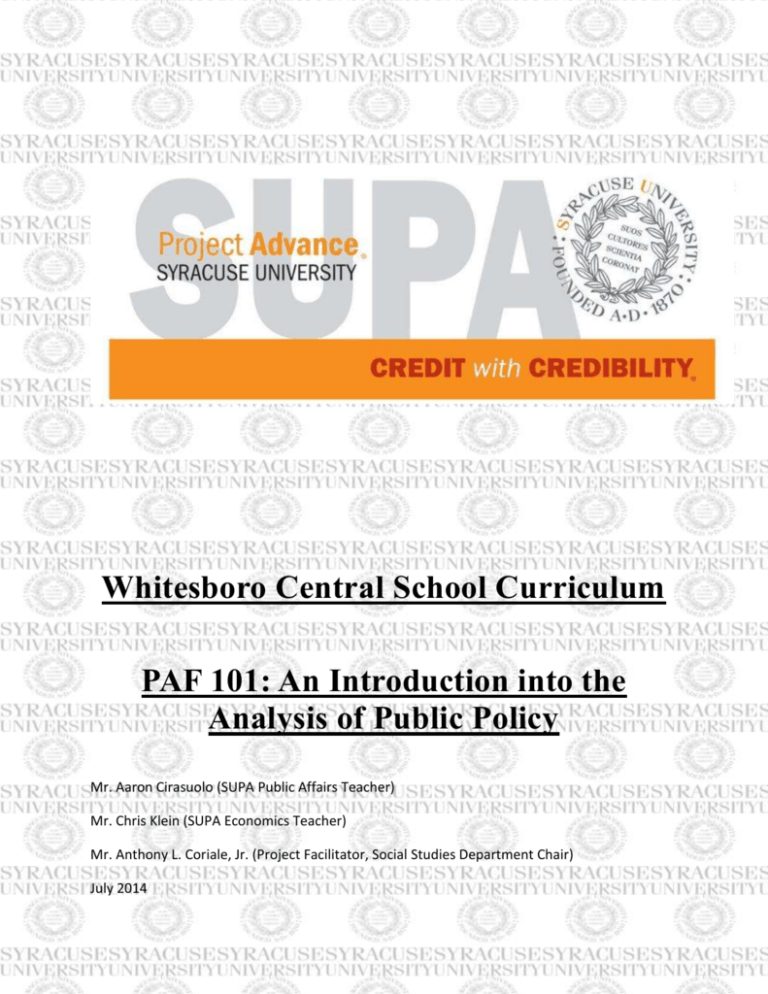
Whitesboro Central School Curriculum PAF 101: An Introduction into the Analysis of Public Policy Mr. Aaron Cirasuolo (SUPA Public Affairs Teacher) Mr. Chris Klein (SUPA Economics Teacher) Mr. Anthony L. Coriale, Jr. (Project Facilitator, Social Studies Department Chair) July 2014 Whitesboro/SUPA Public Affairs Curriculum July 2014 Overview: Syracuse University Project Advance is a cooperative program between Syracuse University and Whitesboro High School that allows high school students to enroll in Syracuse University courses. Teachers who are also adjunct SU instructors teach these classes in the high school, and they follow the curriculum and guidelines established by the University. The Project Advance program enables high school students to gauge their ability to do college work prior to full-time college study. Upon successful completion of a Syracuse University course, students are awarded SU transcripts that record credits earned. These credits are transferable to hundreds of colleges and universities nationwide. For more information about Syracuse University Project Advance, visit www.supa.syr.edu/. (Source: http://supa.syr.edu/index.php) PAF 101 An Introduction into the Analysis of Public Policy: Syracuse University credit: 3 credits An Introduction to the Analysis of Public Policy is unlike any introductory course offered. Students learn how to Do Good and Do Well through outside speakers, debates, group exercises and technical report writing. Students will gain critical job skills that top employers are looking for. On top of all of that? You will not be bored. Students enjoy interacting with the instructor and not being lectured to for 40 minutes. An Introduction to the Analysis of Public Policy fulfills a social sciences and a critical reflections requirement for the Arts and Sciences core. It is also required for all Policy Studies majors. It helps students learn how to do good as a citizen and to do well in your personal life. It develops the research skills that you will use throughout your college career and the rest of your life. An Introduction to the Analysis of Public Policy is divided into five parts. For each part, students will submit a module paper. Class time will be used for lectures, outside speakers, and group exercises. Course Goals: Students improve their skills in the following 10 basic skill sets throughout the course: 1. Taking Responsibility 2. Developing Physical Skills 3. Communicating Verbally 4. Communicating in Writing 5. Working Directly with People 6. Influencing People 7. Gathering Information 8. Using Quantitative Tools 9. Asking and Answering the Right Questions 10. Solving Problems Students will be able to define and apply the following concepts required for public policy analysis. Become willing and able to “do good” effectively. Define and identify the components of public policy issues. Identify a social problem and come up with a proposed public policy to deal with it. List the benefits and costs of a proposed public policy. Develop benchmarks to assess the impact of your policy on societal conditions. Analyze the political factors and develop strategies to implement a proposed public policy. 7. Identify essential features of major current public policy issues. 1. 2. 3. 4. 5. 6. (Sources: http://classes.maxwell.syr.edu/paf101/About.html [adapted] & http://paf101.supa.syr.edu/digital-documents/ [adapted]) There is flexibility for this curriculum to be taught with various instructional strategies and assessments as determined by the individual teacher. Although this curriculum is based on the topics that are required by Syracuse University and certain mandates must be met, the instructor is encouraged to “own” the course, adapting it and designing instruction to fit the needs of the students and employ the instructional strengths of the teacher. Common Core Standards: The SUPA curriculum will incorporate the following Common Core Standards through varied instructional techniques, assessments, and activities. 1. CCSS-RH-11-12.1 2. CCSS-RH-11-12.2 3. CCSS-RH-11-12.3 4. CCSS-RH-11-12.4 5. CCSS-RH-11-12.5 6. CCSS-RH-11-12.6 7. CCSS-RH-11-12.7 8. CCSS-RH-11-12.8 9. CCSS-RH-11-12.9 10. CCSS-RH-11-12.10 11. CCSS-RST-11-12.2 12. CCSS-RST-11-12.3 13. CCSS-RST-11-12.6 14. CCSS-RST-11-12.7 15. CCSS-RST-11-12.8 16. CCSS-RST-11-12.9 17. CCSS-RST-11-12.10 18. CCSS-WHST-11-12.1a 19. CCSS-WHST-11-12.1b 20. CCSS-WHST-11-12.1c 21. CCSS-WHST-11-12.1d 22. CCSS-WHST-11-12.1e 23. CCSS-WHST-11-12.2a 24. CCSS-WHST-11-12.2b 25. CCSS-WHST-11-12.2c 26. CCSS-WHST-11-12.2d 27. CCSS-WHST-11-12.2e 28. CCSS-WHST-11-12.4 29. CCSS-WHST-11-12.7 30. CCSS-WHST-11-12.8 31. CCSS-WHST-11-12.9 32. CCSS-WHST-11-12.10 Learning Standards: The SUPA curriculum for this course will incorporate the following New York State Learning Standards on a daily basis through varied instructional techniques, assessments, and activities. Social Studies 1: History of the United States and New York Social Studies 4: Economics Social Studies 5: Civics, Citizenship, Government ELA 1: Language for Information and Understanding ELA 3: Language for Critical Analysis and Evaluation ELA 4: Language for Social Interaction MST 1: Analysis, Inquiry, and Design MST 6: Interconnectedness: Common Themes MST 7: Interdisciplinary Problem Solving Curriculum Topics and Objectives (The following curriculum objectives are based on the course text: Coplin, William D. The Maxwell Manual for Good Citizenship: Public Policy Skills in Action Croton on the Hudson: Policy Studies Associates, 2007) MODULE 1 Conceptual Overview: Incorporates 1. 2. 3. 4. 5. 6. 7. 8. 9. 10. 11. 12. 13. 14. 15. 16. 17. The mission of the course is to “Do Well” and “Do Good” The ability to identify those who “do well” and those who “do good” The idea to determine the qualities of someone who does well through skill and character, which determine career success Understanding and developing the skills that employers look for in employees The concept to learn by doing An understanding that the Declaration of Independence is the mission statement for public policy in America and the rest of the world The ability to understand the three values of the Declaration of Independence including life, liberty, and the pursuit of happiness Being able to understand how to conduct good analysis including data, clear language, and continuous questioning The idea of understanding what is meant by the concept of “Foolish Freedom” An ability to know what good public policy requires The ability to understand the drivers of human behavior Being able to determine what drives public policy The ability to identify seven societal problem areas including crime, education, environment, health, housing, jobs/ economic development, and poverty Being able to describe how each of the four drivers (fear, greed, guilt, and love) shape policy in current public policy discussions Defining and understanding Federalism Understanding the political ideological spectrum Determining where an individual lies on a political spectrum MODULE 2 Conceptual Overview: Incorporates 1. 2. 3. 4. 5. 6. 7. 8. 9. Multiple information formats & retrieval tools The requirement of significant time investment An ability to increase familiarity & comfort level with use of a research library Calling for navigating a series of research exercises where attention to detail is essential An understanding for designing effective, meaningful surveys Being able to know the key concepts of survey sampling Knowledge of methods to conduct surveys An ability to identify the concept of “confidence interval” Being able to distinguish between “open” and “closed” questions MODULE 3 Conceptual Overview: Incorporates 1. 2. 3. 4. 5. 6. An ability to describe a societal problem An ability to discover evidence of the problem An effort to find causes to the societal problem Knowledge of the existing public policy Knowledge of the role of private and non-profit sectors Being able to identify policy alternatives and selecting alternatives on the basis of effectiveness and feasibility 7. Being able to distinguish between policy and problem MODULE 4 Conceptual Overview: Incorporates 1. 2. 3. An understanding of the role and purpose of benchmarking An ability to calculate percent change utilizing Excel Developing a baseline forecast, setting a benchmark, and using benchmarks to support policy proposal 4. An understanding for determining the benefits and costs of a policy proposal An examination of The Seven Habits of Highly Effective People (Stephen R. Covey) as it relates to policy 6. A discussion of the ten skills employers want students to learn in college 5. MODULE 5Conceptual Overview: Incorporates 1. 2. 3. 4. Developing an understanding of what the Prince System is An examination of the steps utilized by the Prince System An analysis and discussion of the layers of government Knowledge on how to develop political strategies using skills such as a position on an issue and priority and power levels 5. Thinking about strategies to use in understanding a position on an issue as well as changing a position 6. Developing an understanding of what is a change agent and an example of a change agent 7. Knowing what change is, how it occurs, what drives change, and the value of compromise 8. Being able to define “doing good” 9. Understanding that public policy is about doing good 10. Knowing the keys to effective volunteering COMMUNITY SERVICE Community service is a course requirement. Students are expected to perform five (5) hours of community service and complete appropriate paperwork. Community service is to be done for a nonprofit or governmental agency. It cannot be done in a school setting. SUPPLEMENTAL MATERIALS THIS CURRICULUM WAS DESIGNED TO MEET THE REQUIREMENTS OF SYRACUSE UNIVERSITY AND PROVIDE A BASIC GUIDLEINE FOR THE COURSE. IT IS ANTICIPATED THAT THE STRUCTURE OF THE COURSE WILL CONTINUE TO EVOLVE AND ADDITONAL MATERIALS BE USED AS THE INSTRUCTOR MASTERS THE COURSE. IT IS SUGGESTED THAT THE FOLLOWING MATERIALS BE INCLUDED IN THE COURSE OR INCORPORATED IN FUTURE CURRICULUM WRITING TO ENHANCE THE COURSE AND ADDRESS COMMON CORE STANDARDS: Town/ County Government Construction and Public Issues Project “Keeping the Mohawk Valley Young” Project o These projects are designed to be phased in with the SUPA Economics curriculum as the courses evolve to facilitate collaboration among these integrated topics Political Ideology Project Various classroom seminars provided by local officials as guest presenters SUPA An Introduction into the Analysis of Public Policy Course Outline TOPIC APPROXIMATE LENGTH MODULE 1 Chapter 1 – Three Essential Components for Public Policy 3 Week s Analysis and Action MODULE 2 Chapter 2 – Getting Information from Published Sources 2 Weeks Chapter 3 –Gathering Information from Players and Experts 1 Week Chapter 4 – Surveying Stakeholders 2 Weeks MODULE 3 Chapter 5 –Describing the Problem and Identifying Its Causes 2 Weeks Chapter 6 – Formulating a Public Policy 1 Week MODULE 4 Chapter 7 – Examining the Benefits and Costs of a Policy 2 Weeks Chapter 8 – Benchmarking Public Policy 2 Weeks MODULE 5 Chapter 9 – Forecasting Implementation with the Prince System 2 Weeks Chapter 10 – Developing Political Strategies 1 Week Memo 1-2 Weeks
